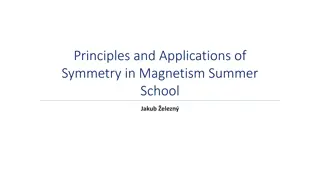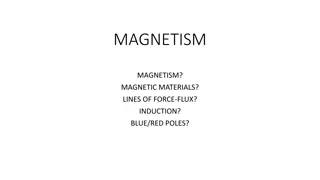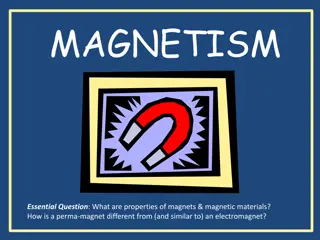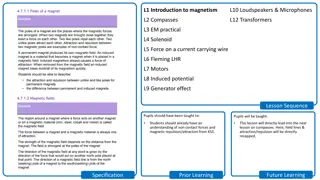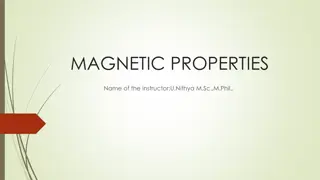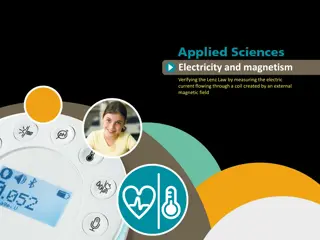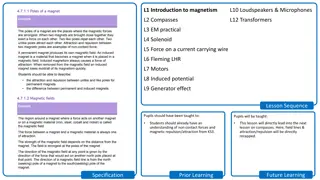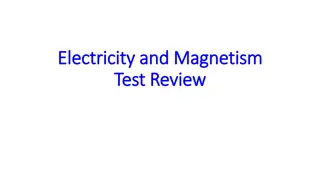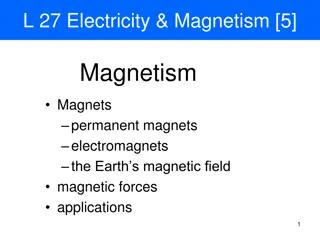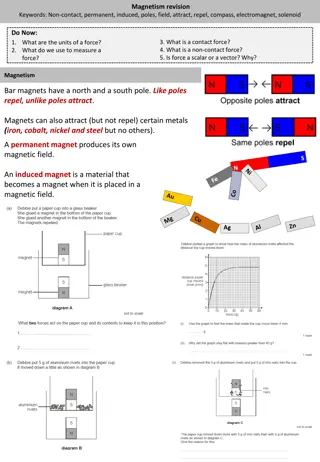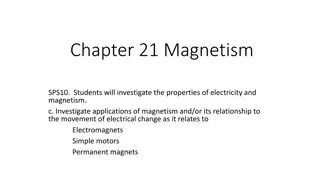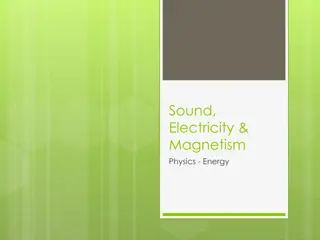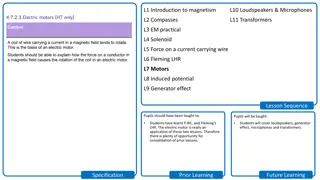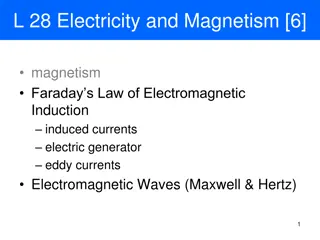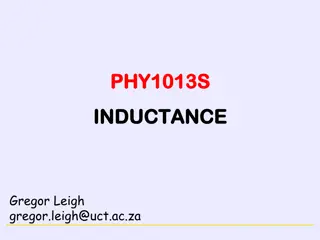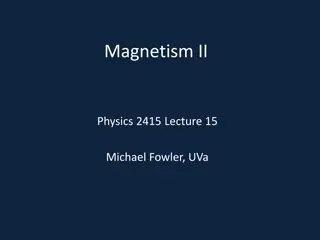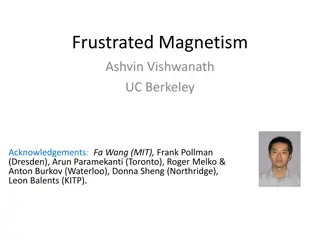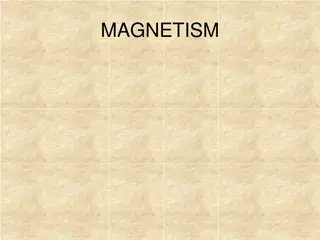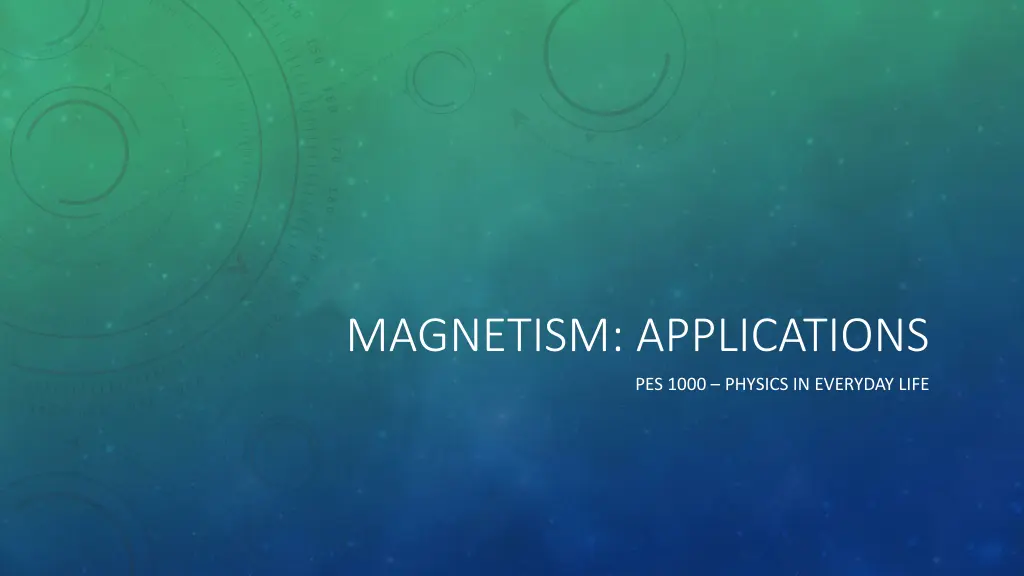
Applications of Magnetism in Everyday Life
Explore the practical applications of magnetism, from understanding magnetic force on moving charged particles to the workings of electric generators, motors, and cyclotron motion. Learn about how Earth's magnetic field influences phenomena like auroras.
Download Presentation

Please find below an Image/Link to download the presentation.
The content on the website is provided AS IS for your information and personal use only. It may not be sold, licensed, or shared on other websites without obtaining consent from the author. If you encounter any issues during the download, it is possible that the publisher has removed the file from their server.
You are allowed to download the files provided on this website for personal or commercial use, subject to the condition that they are used lawfully. All files are the property of their respective owners.
The content on the website is provided AS IS for your information and personal use only. It may not be sold, licensed, or shared on other websites without obtaining consent from the author.
E N D
Presentation Transcript
MAGNETISM: APPLICATIONS PES 1000 PHYSICS IN EVERYDAY LIFE
MAGNETIC FORCE ON A MOVING CHARGED PARTICLE ?? When a charge moves through a uniform magnetic field, it experiences a force that is perpendicular to the field and to its direction of motion. To make this geometry easier to draw, a notation for a magnetic field directed toward or away from the observer was developed. Field lines toward the observer are drawn as dots or circled dots. Field lines away from the observer are drawn as X s or circled X s. To remember which is which, imagine an arrow fired from a bow. The observer would see the tip of the arrow (dot) if it was moving toward them, and an X (the feathers) if it was moving away. The notation can be used for any vector, including the force and velocity vectors. ? + Away from observer ? ?? Toward observer
I ELECTRIC GENERATORS Picture a conductor moving across magnetic field lines: Electrons in the wire are a moving charge, so there is a force generated on them along the wire, generating a current. Now imagine you rotate a wire loop between permanent magnets: As one wire crosses magnetic field lines and generates a current, the other wire is crossing the opposite way. Together, they push current around the loop. Current will rise and fall as each wire passes through the field, slows, reverses, passes through again, slows, This naturally generates an alternating current. More loops generate more current. Alternating Current
ELECTRIC MOTORS Electric motors have a similar design to electric generators. There is a loop of wire within permanent magnets. In this case, though, a direct current is run into the loop. The current through the bottom wire causes a sideways force on the wire. The opposite current through the top wire causes an opposite force. These forces generate a torque, which turns the axle of the motor. Torque FB A mechanism called a split-ring commutator switches the current s direction just as the loop reaches equilibrium, causing the loop to keep spinning. Direct Current
CYCLOTRON MOTION + - Imagine a uniform magnetic field directed outward toward the observer. Inject a positively charged molecule (ion) into the field with a velocity perpendicular to the field. The moving charge in the magnetic field experiences a magnetic force. The force is perpendicular to the velocity (and the field). This force accelerates the particle, not along its path, but sideways to it. As the particle turns, the force turns with it, causing a circular path. The magnetic force causes centripetal acceleration. Here is how the circle depends on the parameters of the situation: ? =? ? + ? ? ?? Applications: + + + Mass spectrometer: Since the size of the circle depends on the mass of the particle, we can determine that mass Anti-matter detector: Since the direction around the circle depends on the sign of the charge, we can detect the difference between matter and anti-matter ?
AURORAS The Earth has natural magnetic field. Charged particles from the Sun encounter Earth s magnetic field. They will experience cyclotron motion about the field lines, and the circle will drift along the field lines, forming a spiral. The charged particles then hit atmospheric particles, causing them to emit light. This is how the auroras are generated. + ?
INDUCTIVE SENSORS When the magnetic properties of an AC circuit change, there is a voltage change. This is how a traffic light trigger works. AC current flows back and forth through the coil and the voltage from coil s self-inductance is monitored. If a piece of metal enters the alternating magnetic field, currents are induced in it from the detector. AC Current These currents generate their own magnetic field, influencing the magnetic field of the coil. This results in a drop in the circuit s voltage, which then triggers some action. This is also how metal detectors work. Metal that passes into the field triggers a change in the circuit s voltage.
TRANSFORMERS Primary Secondary Transformers give us the ability to reduce the cost to transmit power by lowering the current with high-voltage wires. Transformers work by magnetic induction, which requires that the current be constantly changing, as it does in an AC circuit. The primary side is the power-supply side, and the secondary side is the power-consumption side. There are a different number of coils on the primary (NP) and secondary (NS) sides. They are wrapped around an iron core. The primary coils generate an alternating magnetic field which the iron core magnifies and directs through the secondary coils. The alternating magnetic field induces a current on the secondary side. The change in current and voltage depend entirely on the relative number of coils on the two sides. ?? ?? ?? ?? ?? ?? ??=?? ???? ??=?? ?? ?? ? = ? ?
CONCLUSION Magnetic fields are used in many ways in modern life. Electric generators transform mechanical rotation into alternating current by moving wires through a permanent magnetic field. Electric motors transform electric current into mechanical rotation by running a current through wires near a permanent magnetic field. Charged particles that move through a magnetic field will be forced into circles about the magnetic field lines. This can be used to determine the mass or charge of particles too tiny to measure otherwise. The aurora effect is a result of this phenomenon. Magnetic induction is the basis of sensors like traffic light triggers and metal detectors. Magnetism allows transformers to adjust current and voltage for efficient power transmission.

